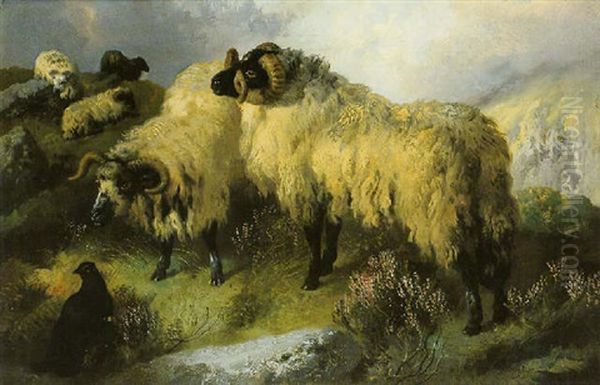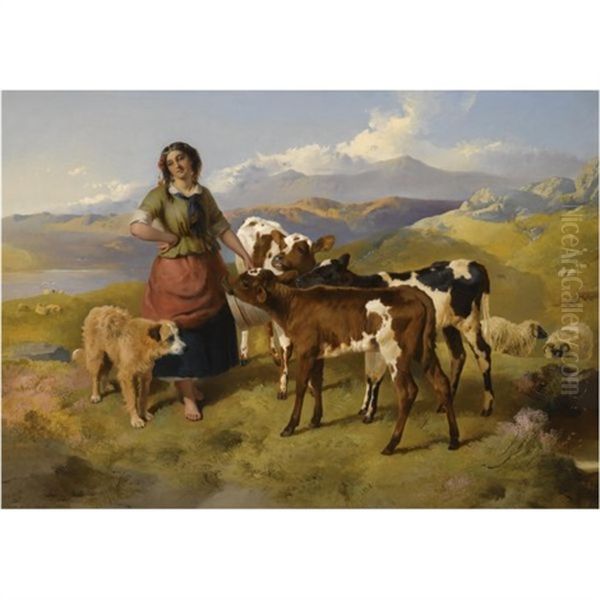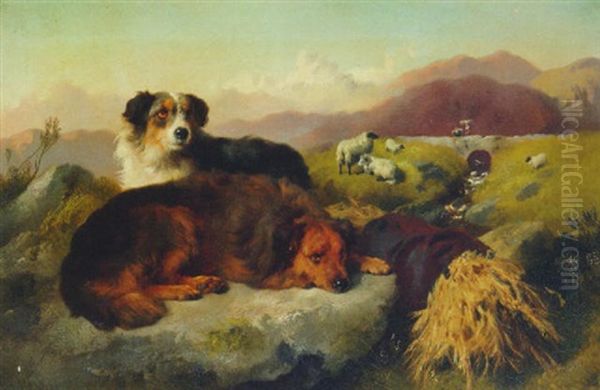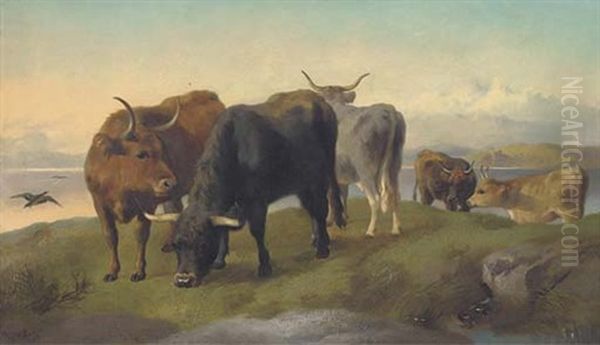George William Horlor, often recorded as George W. Horlor, stands as a figure of interest within the sphere of nineteenth-century British art. Primarily recognized as an animal and sporting painter, his work captures the essence of rural life, particularly focusing on the landscapes and fauna of the British Isles, with a special emphasis on Highland scenes and the animals associated with them, such as dogs, sheep, and game birds. His career spanned a significant portion of the Victorian era, a time of great change and flourishing activity in the British art world.
Understanding Horlor begins with acknowledging some ambiguity surrounding his fundamental biographical details, particularly his dates of birth and death. This uncertainty highlights the challenges often faced by art historians when piecing together the lives of artists who may not have achieved the highest echelons of fame but still contributed significantly to the artistic landscape of their time.
Biographical Sketch and Working Life
Information regarding George W. Horlor suggests he was actively painting from the mid-nineteenth century onwards. His professional life saw him based in several locations across England, including Cheltenham, Birmingham, and later Brentford. This geographical movement might reflect the typical trajectory of a working artist seeking patronage, exhibition opportunities, or perhaps simply different environments for inspiration.
A significant aspect of his career was his regular participation in exhibitions at the prestigious Royal Academy of Arts in London. Acceptance into the Royal Academy's exhibitions was a crucial step for many artists seeking recognition and sales. Horlor's consistent presence there indicates a level of professional success and acceptance within the mainstream art establishment of the day. His focus on animal and sporting subjects was a popular genre during the Victorian era, appealing to landowners, country gentlemen, and those nostalgic for rural pursuits.
The Question of Dates and Origins
One of the most immediate points of confusion surrounding George W. Horlor concerns his lifespan. The provided source materials present conflicting information. One source suggests his dates are 1823 to 1895. This places his birth firmly in the Georgian era and his death towards the end of the Victorian period, giving him a relatively long life and career.

However, another source cited offers different dates: 1849 to 1891. This timeline presents a significantly shorter life and a career concentrated in the latter half of the nineteenth century. The source material analysis leans towards accepting the 1849-1891 dates as potentially more accurate, citing the provision of more detailed accompanying information, such as specific exhibition years (1849-1890) and named works associated with this timeframe. If correct, this would make him a contemporary of later Victorian art movements.
Adding another layer of complexity is the information regarding his birthplace. While his career, exhibition history (Royal Academy, London), and subject matter (British Highlands, sporting dogs common in Britain) strongly point towards a British identity, one piece of evidence within the provided text explicitly states his birthplace as Logan County, Illinois, in the United States. This stands in stark contrast to the prevailing narrative of a British artist working in England. Without further corroborating evidence, this detail remains a puzzling anomaly within his biography as presented in the source material. It highlights the potential for conflicting records or misattribution in historical data.
Regarding his artistic training, the available information suggests that Horlor may have been largely self-taught. There is no specific mention of formal instruction at an art academy or university. This was not entirely uncommon in the 19th century, where talent, observation, and practice could still lead to a successful artistic career, particularly in genres like animal painting that required keen observation of nature more than academic figure drawing.
Artistic Style and Thematic Focus
George W. Horlor dedicated his artistic practice primarily to oil painting. His chosen subjects were animals and the landscapes they inhabited, often intertwined with human activities like hunting and farming. He is particularly noted for his depictions of the Scottish Highlands, capturing the rugged beauty of the terrain and populating it with characteristic wildlife and domestic animals.
His style can be characterized by a detailed naturalism, especially in the rendering of animals. He paid close attention to the anatomy, fur, and feathers of his subjects, striving for lifelike representation. Whether painting sporting dogs like setters and retrievers, herds of cattle, or flocks of sheep, Horlor aimed to capture their characteristic poses and behaviours within their natural environment.

There's often a pastoral or romantic sensibility in his work. His Highland scenes, even those depicting hunting, tend to emphasize the grandeur and atmosphere of the landscape. The animals are presented with a degree of dignity, reflecting the Victorian era's complex relationship with nature – one that combined exploitation through sport and agriculture with a growing appreciation for the picturesque and the wild. His paintings evoke a sense of the outdoors, appealing to a contemporary taste for scenes of rural Britain.
Representative Works
Several specific works are mentioned as representative of George W. Horlor's output, showcasing his thematic interests and artistic skill:
Highland scene with sheep and grouse: This title immediately brings to mind a classic Horlor subject – the Scottish landscape populated by iconic fauna. One can envision rolling hills, perhaps heather-clad, with a flock of sheep grazing peacefully while game birds like grouse are subtly integrated into the scene, possibly indicating the potential for sport or simply adding to the naturalistic detail.
A Golden Retriever, an Irish Setter, and a Gordon Setter in a Mountainous Landscape: This painting highlights Horlor's skill in portraying specific breeds of sporting dogs, animals highly valued for their roles in hunting. Placing them in a mountainous landscape reinforces the connection to outdoor pursuits and the rugged environments where these dogs would work. The composition likely emphasizes the noble bearing and alertness of the dogs.
Calves Feeding: Shifting slightly from sporting themes, this work focuses on pastoral life and animal husbandry. It suggests a gentler scene, perhaps depicting young cattle in a field or barn setting. Such paintings appealed to a sense of idyllic ruralism and the connection between humans and domestic animals.
After a Day's Sport in Perthshire: The title clearly indicates a narrative moment related to hunting. Perthshire, a county in Scotland known for its dramatic landscapes and sporting estates, provides the setting. The painting likely depicts hunters and their dogs resting after a successful outing, perhaps showcasing the day's bag, emphasizing camaraderie and the rituals of the sport.
A Shooting Party in the Highlands: Similar to the previous work, this title suggests a scene focused on the social aspect of hunting. It might depict a group of sportsmen, possibly with ghillies and ponies, setting out for or returning from a shoot in a dramatic Highland setting. Such works often celebrated the traditions and lifestyle associated with landed estates.

Sheepdogs Resting in a Mountain Landscape: This work combines Horlor's interest in dogs with the pastoral theme. Sheepdogs, essential working animals in the Highlands, are shown at rest, likely watching over their flock against a backdrop of mountains. It highlights the intelligence and loyalty of these animals and their integration into the landscape.
These titles collectively paint a picture of an artist deeply engaged with the animals and landscapes of Britain, particularly Scotland, and the human activities, both sporting and agricultural, that took place within them.
Horlor in the Context of Victorian Art
To fully appreciate George W. Horlor's contribution, it's helpful to place him within the broader context of 19th-century British art. The Victorian era saw a huge expansion in the art market and a diversification of genres. Animal painting, in particular, reached a peak of popularity, arguably spearheaded by the immense success of Sir Edwin Landseer. Landseer's dramatic and often anthropomorphic depictions of animals, especially stags and dogs, set a high standard and influenced many artists.
Horlor worked concurrently with or slightly after Landseer, inheriting a public appetite for animal subjects. Other notable contemporaries specializing in animal or sporting art included Richard Ansdell, known for his detailed paintings of animals, often in Spanish or Scottish settings, and Briton Rivière, who often imbued his animal subjects with narrative or emotional weight. The Herring family, particularly John Frederick Herring Sr. and John Frederick Herring Jr., were also highly prominent painters of horses, racing scenes, and farmyard animals.
Beyond dedicated animal painters, the landscape was a dominant theme in British art. Horlor's Highland scenes connect to a tradition of depicting the British landscape, carried forward by artists like Benjamin Williams Leader, known for his picturesque views of the English and Welsh countryside, often featuring silver birches and tranquil waters. The detailed observation in Horlor's work also echoes the Pre-Raphaelite Brotherhood's emphasis on truth to nature, although his style remained more traditional. Key figures associated with the Pre-Raphaelites or their influence, like John Everett Millais (who later became President of the Royal Academy), were major forces during Horlor's active years.

The Royal Academy, where Horlor exhibited, was the epicentre of the British art world. It was dominated by figures who achieved great public acclaim, such as William Powell Frith, famous for his panoramic depictions of modern life like 'Derby Day', and later, Frederic Leighton, who brought a classical grandeur to British art and served as President of the Royal Academy. While Horlor focused on a specific niche, his regular exhibition alongside these luminaries demonstrates his participation in the mainstream artistic life of the period. Other artists focusing on rural life and landscapes, like Myles Birket Foster (primarily in watercolour) and Thomas Sidney Cooper (renowned for his paintings of cattle and sheep), also shared the artistic stage, contributing to the rich tapestry of Victorian art that celebrated Britain's natural heritage and rural traditions.
Associations and Personal Life
Despite his activity within the London art scene via the Royal Academy exhibitions, the provided source material indicates no specific records of George W. Horlor collaborating directly with other named artists. Nor is there mention of him belonging to any particular art societies or groups beyond his participation as an exhibitor at the RA. His career appears to have been that of an independent artist cultivating a specific market for his work.
The sources do mention other individuals named Horlor, such as Joseph Horlor (potentially another artist) and Sean Horlor (a modern-day poet and director), but explicitly state these references are not directly connected to George W. Horlor based on the information available. Similarly, the mention of the famous American landscape painter Albert Bierstadt appears contextually within the source documents but without any suggested link to George W. Horlor.
Furthermore, the available information is notably silent on Horlor's personal life beyond his professional activities. There are no documented anecdotes, personal controversies, or significant life events mentioned in the provided texts. His legacy, therefore, rests primarily on his artistic output – the paintings that survive and attest to his skill in capturing the animals and landscapes he observed.
Legacy and Conclusion
George W. Horlor emerges from the historical record, albeit with some biographical uncertainties, as a competent and dedicated British painter specializing in animal and sporting subjects during the latter half of the nineteenth century. His work fits comfortably within a popular Victorian genre, celebrating the beauty of the British landscape, particularly the Scottish Highlands, and the animals, both wild and domestic, that inhabited it.
His regular exhibitions at the Royal Academy suggest a sustained professional career and a degree of recognition within the contemporary art world. While perhaps not reaching the fame of contemporaries like Landseer, his paintings, such as Highland scene with sheep and grouse or A Golden Retriever, an Irish Setter, and a Gordon Setter in a Mountainous Landscape, demonstrate considerable skill in animal portraiture and landscape rendering. He catered to a taste for naturalism, pastoralism, and scenes connected to rural life and sporting pursuits.
The conflicting information regarding his dates (1823-1895 vs. 1849-1891) and the intriguing but potentially erroneous mention of an American birthplace highlight the need for further research to clarify his biography definitively. However, based on his body of work and exhibition record, his primary identity remains that of a British artist contributing to the rich tradition of animal and landscape painting in the Victorian era. Lacking records of collaboration, group affiliations, or personal controversies, George W. Horlor is remembered through his canvases, which continue to offer glimpses into the natural world and rural pastimes of nineteenth-century Britain.